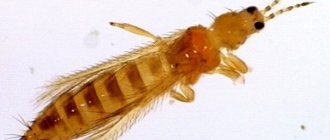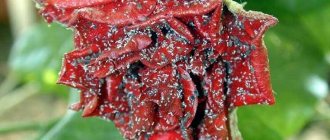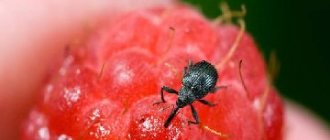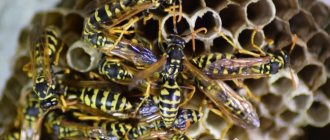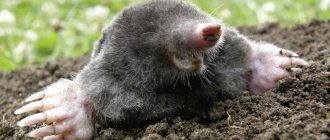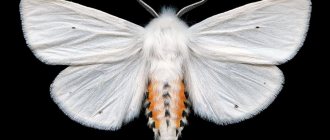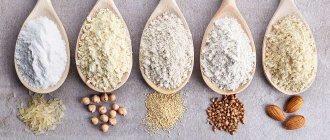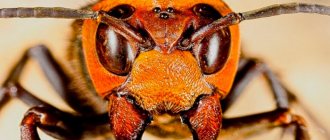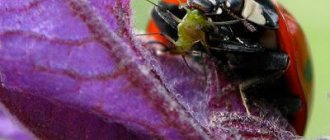Causes of aphid attacks on plants
In autumn, female aphids lay eggs that are fertilized by males. They hide in the bark of bushes, sometimes they are covered by ants along with their clutch. After surviving the winter, the eggs hatch to produce winged female aphids that can reproduce without the need for a male. Parthenogenesis – the ability of pests to reproduce independently – provides an advantage for the survival of the species and parasitism on cultivated plants. In addition, the process of population increase occurs at an incredible speed: the number of insect individuals increases almost exponentially. One female is able to lay up to hundreds of eggs, each of which gives birth to aphids, which, in turn, are also divided by parthenogenesis.
Direct reasons for the appearance of aphids on the site:
- anthill;
- weed;
- the proximity of peppers to other flowering plants;
- the presence of aphid larvae in the soil;
- infected seedlings;
- excessive watering;
- incorrect temperature.
Where do aphids come from on peppers?
Aphids easily tolerate winter cold in the soil. Maybe she will survive the hibernation season in withered foliage. It is in last year’s “leaf fall” or in the bark of trees and shrubs that the eggs of these pests are stored until the next life cycle. With the first warm days, female aphids wake up, which subsequently create entire colonies of parasites.
Ants also play an important role in the spread of aphids, for which these insects are something like livestock. Ants drag aphids, protect them, and in return receive honeydew - milk - from the pest insects. Thanks to such protection and transportation, aphids quickly develop and spread, expanding their range. So aphids often appear in houses where there are ants.
Why are peppers so attractive to aphids? It's all about the juicy leaves and shoots, which are rich in nutrients. Therefore, the choice of soil for planting seedlings or indoor plants must be approached very responsibly. It’s best to purchase soil mixture at the store.
What varieties can be found on the vegetable?
Today, on average, five main types are known: nightshade, greenhouse, peach, green and black aphids. It should be noted that the last two insects are considered the most dangerous: they not only parasitize the plant and feed on its vital juices, but also produce a substance that is a nutrient medium for fungi. Basically, aphids parasitize directly on peppers, but under favorable conditions they spread to melons, cabbage and ornamental flowers. This must be taken into account when planting different types of plants in the neighborhood.
Green
Green aphids settle in large colonies on young pepper seedlings. A distinctive feature of this species is its love for flowering shoots. That is, by the end of spring, insects climb onto the stems and leaves of the plant, but aphids begin their violent reproduction closer to the budding and fruiting phase. Until this time, it is difficult to notice them, since the main group of insects hides at the place where the leaf attaches to the stem.
Black
The black aphid, also known as the house aphid, is the smallest insect and a member of the family. Small, no more than 0.3 mm in size. It is common for black aphids to live on the stem and inside of young pepper leaves. Nutrition mainly comes from the nutritious juices of the plant, and the most important elements in the aphid diet are carbohydrates and proteins, broken down into amino acids. Therefore, it is not at all surprising to notice this parasite on young shoots. In addition, during digestion, aphids secrete honeydew, which tastes sweet and attracts ants. Most often, these two types of insects work together, therefore, where aphids appear, ants will soon appear, and vice versa.
Carefully! Pests may move into your home.
Peach
A small, oval-shaped insect. Larger than black aphids: size ranges from 1 to 2 mm. Like other species of this family, the peach aphid appears, reproduces and lays eggs on the inside of the pepper leaf, but differs in appearance - the insect’s body covers are colored in red and orange tones. The name is due to the fact that this type of aphid was discovered on peach trees. It follows from this that when peaches and peppers are adjacent, the parasite can spread from one plant to another.
Greenhouse
The third largest aphid, its body length is from 2 to 3 mm. Externally, the insect more closely resembles the green variety, but the size characteristic turns out to be the decisive difference. The main feature of the greenhouse specimen is that it is extremely thermophilic. The favorite “nesting” place for this parasite is greenhouses, therefore, it will not spread to cultivated plants outside the greenhouse.
Nightshade
The largest insect of the entire family: average size 4 mm. The body of the nightshade aphid is covered with light green chitin, however, this pest is unlikely to differ from other species in its behavior.
Types of aphids that parasitize peppers
Aphids are insects measuring 2-3 mm. The largest species reach 7 mm. All plant parasites of this family are equipped with a proboscis that pierces plant tissue, sucking juices from them.
There are about 5,000 species of aphids in nature, but only a few species pose a threat to pepper seedlings. These include potato, cotton (melon) and peach varieties.
Aphids that parasitize peppers are also carriers of infectious diseases that threaten the complete death of seedlings.
Potato
Adults have an elongated body ranging from 2 to 3.5 mm in length. Outwardly they look like translucent insects of light green color. In the wingless virgin stage, potato aphids may be red in color.
Cotton
This species is considered one of the most dangerous for peppers and other nightshade crops. The length of the insect rarely exceeds 2 mm. Cotton aphids are usually black with a greenish tint, sometimes yellow or green.
Peach greenhouse
Greenhouse aphids on peppers often appear after planting plants in open or protected ground. However, the pest can infect flowers growing on the windowsill, from which it safely migrates to the pepper seedlings. The length of the body is within 2 mm. The typical color of the representative is black and green.
Signs of insect presence
Yellowing, curling and falling leaves
The leaves of young sweet peppers turn yellow and curl, after which they simply fall off. Why is this happening? The fact is that aphids feed on plant juices containing nutrients, which is why the plant itself lacks them. Young seedlings whose root system has not had time to develop to the required level and cannot cope with the unexpected load on their body are especially susceptible to this. Young shoots may well wither and die completely.
The grown inflorescences fall off
A small seedling will die, but an adult and healthy plant will survive the aphid attack and stoically continue to reach for the sun. All nutrition received from the soil and fertilizer will be used to maintain life - roots, stems and leaves. But a culture must produce offspring - bloom and form fruit. Because of the aphids, the pepper does not have enough resources for it, so the already grown inflorescences fall off and crumble.
Viscous liquid on the plant
Another sign of the appearance of parasitic insects on young sweet peppers is the inevitable appearance of a liquid and viscous substance on the stem, which is popularly called honeydew. In fact, this is a very multifaceted phenomenon because:
- on the one hand, it is a nutrient for ants, which is why the latter enter into symbiosis with aphids and protect these insects from others, such as ladybugs and Colorado potato beetles;
- on the other hand, honeydew is a good breeding ground for the development of mold fungi. Their presence on a plant is an almost absolute guarantee of the development of mold mycoses, because, unlike animals, green spaces do not have an immune system. Without human help, a pepper crop affected by a fungus dies.
Egg clutches of aphids on the back of a leaf
Proximity of nutritional resources, shelter from rain, wind and sun, protection by ants from natural enemies - all these are reasons for aphids to settle in pepper for a long time. This is where the pest will reproduce and lay eggs. One female produces up to a hundred eggs during her life; they form into a clutch that is quite convenient for protection. One tiny egg is difficult to distinguish with the naked eye, but their accumulation is becoming more noticeable.
In addition, if an aphid parasitizes a plant for a long time, the latter changes structurally:
- the “immunity” of culture, if you can call it that, is undermined. The plant tolerates other types of diseases worse;
- “sooty” mold fungi are added to parasitism by insects;
- the shape of the shoots changes.
The structure of plant cells and tissues is disrupted. To prevent irreversible changes, it is necessary to begin fighting insects as soon as they are noticed.
Description
Aphids are small insects belonging to the order Homoptera. The parasite uses plant sap for nutrition, sucking it out of leaves, non-lignified stems, flowers and ovaries. There are more than 3,500 species of aphids in nature. Of these, about 1000 live in European countries. Insects live in numerous colonies, multiply and spread quickly.
The average size of adults is 2 to 3 mm. But some species reach a length of up to 7 mm. They have an oval body with a sucking mouthpart at one end. The insect pierces the shell of leaves and stems using its proboscis. The pest uses 3 pairs of limbs to move. Adults come with or without wings. You can see the aphids in more detail in the photo. Winged insects migrate, flying from one plant to another in search of food.
Of all the known varieties of aphids on bell peppers, the following appear:
- Peach does not exceed 2 mm in length. Usually its body is colored translucent green, but sometimes red individuals are found.
- Greenhouse mainly affects plants in greenhouse or greenhouse soil. Adults reach a length of 3.6 mm. Their body is green in color, sometimes a stripe of a darker shade runs along the back.
- The nightshade or black aphid is the smallest. The body size of an adult does not exceed 1 mm. The color varies, but black insects often appear on bell peppers.
Aphids reproduce at a high rate. An adult female reproduces 3 generations per month. Moreover, in one clutch she makes up to 150 eggs. The larvae that hatch from them turn into sexually mature individuals in just 7 days. During the summer, aphids reproduce asexually. Most often, wingless individuals are born, but sometimes winged ones are found among them. They fly to healthy plants and infect them. With the onset of autumn, sexual reproduction of aphids begins. Then the laid eggs are stored until spring.
On a note!
Aphid reproduction occurs most rapidly at temperatures from +25°C to +30°C. When the temperature drops to +20°C, reproduction slows down by half. Then the insects develop more slowly, reaching sexual maturity in 2 weeks.
How can you fight the invasion?
Most people have no idea how to get rid of aphids on peppers. This is not difficult; there are many ways to combat insects - from the ability to treat them at home to professional chemical and biological insecticides. Periodically, a complex of works is carried out at once, combining different possibilities. Some of them are less effective, others more. Typically, two or three treatments of the plant against insects are carried out at equal time intervals. If aphids on pepper seedlings have infested a large number of young seedlings, then the most suitable method would be to use Dichlorvos against insect pests.
Rating of the best means to treat beets against aphids
Causes of the pest
The main reason why aphids may appear on peppers is soil contaminated with their larvae. Once in favorable conditions, they begin their development cycle, turning into sexually mature individuals, and move to young plants.
Aphids can attack seedlings by migrating from home flowers. Insects often parasitize indoor plants, which may not be noticed by the gardener. Flowers have stronger tissues that are more difficult for aphids to bite through, so traces of their vital activity may not be detected. The reasons for the appearance of the pest on flowers are also associated with the use of contaminated soil.
Chemicals
The main thing when using chemicals is to spray them in an open space. The plants in the greenhouse will not be harmed, however, it is necessary to isolate agricultural productive animals and insects from the direct and indirect effects of insecticides.
Karbofos
Karbofos is a popular and long-proven product on the market that can be used to fight aphids at home. The product is sold in powder form in plastic packaging. It is diluted with water in the proportion of one tablespoon of the substance per liter of water. An important feature: treatment with Karbofos is carried out before the sweet pepper begins to bloom, otherwise toxic substances will enter the fruit forming on the shoot of the plant. Such peppers will be unsuitable for food.
Fufanon
The second most effective means of combating not only aphids, but also other parasitic insects is Fufanon. It acts faster than any other chemical treatment, however, it is as toxic as Karbofos.
Aktara
Mainly used to treat young plants. Aktara is produced in bottles with a viscous concentrated liquid, which is diluted in a ratio of 5:10,000. That is, per liter of liquid you will need only 0.5 ml of active substance. A systematic approach is required; plants are processed at intervals of three days during the week. After this, all aphids are removed without a trace.
If the treatment course is not completed, parasitic insects may become resistant to this type of chemical.
Fury
Another chemical suitable for processing vegetables and fruits. The toxins in its composition pass into the fruit, so it cannot be used on plants during flowering and fruiting. During this period, it is worth using non-chemical methods to combat parasitic insects.
Intavir
This drug is made in tablets, therefore, there is no point in diluting it to a certain extent. One tablet dissolves in 10 liters of water. Depending on the scale of the disaster, two pieces may be needed. You need to process it twice, every other week. Intavir is multitasking: it also destroys the Colorado potato beetle.
Attention! The use of this remedy is not entirely advisable, since other insects are natural competitors of aphids.
Aktellik
A liquid toxic substance that affects insects through the gastrointestinal tract. Available in two ml ampoules, which are diluted into two liters of liquid. It is important to use away from apiaries, since bees are also insects.
Spark
Powdered insecticide. The solution is diluted according to the instructions on the package. The resulting mixture is sprayed onto the plantings once.
Advice! Iskra is usually used for prevention. If there is a need to treat plants against an already highly developed aphid infestation, then it should be combined with other drugs.
Tanrek
It accumulates in the soil, which is why one treatment is enough for plants for a long period of time.
Carefully! Most insecticides used on a large scale are harmless to humans and animals, but can have a negative effect when sprayed directly onto the mucous membranes of the eyes, nose and mouth. Precautionary measures - protective clothing: gloves and bandages.
Ways to combat aphids
There are several methods to free pepper plantings from aphids. The appropriateness of using each of them depends on the severity of the problem.
Mechanical method
Aphids that have not had time to reproduce can simply be removed from the leaves and then destroyed in any convenient way. It is also effectively washed off with a strong stream of water. Severely damaged parts of plants, abundantly covered with aphids, are cut off and burned.
Biological drugs
Biological “weapons” are used when the pest spreads insignificantly.
This method, like the mechanical one, is harmless to plants and does not introduce toxic substances into the fruit. It involves attracting insects that feed on aphids, for example:
- ladybug (larvae and adults);
- hoverfly;
- some types of wasps;
- lacewing.
Insects and larvae can be purchased from garden centers (ladybug and lacewing). They also actively make their way into the greenhouse naturally when spicy and fragrant herbs (for example, dill), umbrella-type weeds (clover, etc.), nettles, and various green manures (plants grown for subsequent incorporation into the soil as fertilizers) grow in it. .
Examples of green manure are vetch and rapeseed.
Folk recipes
Folk remedies have a number of advantages:
- high efficiency;
- low cost;
- environmental friendliness (fruits remain environmentally friendly).
Widely used compositions:
- A solution of laundry or liquid soap. It is useful to add kerosene or a mixture of ash, sunflower oil and ammonia.
- A water infusion of finely chopped tomato leaves.
- An infusion of crushed garlic with the addition of liquid soap and any vegetable oil.
Gardeners practice the following infusions:
- hot pepper;
- ash;
- onion peel;
- nettle;
- marigolds;
- white mustard: 30 g of it is brewed in 500 ml of boiling water and left for three days. In fourths, the mass is diluted with water so that the resulting volume is 10 liters;
- citrus fruits;
- onions;
- tobacco dust;
- pine needles and shag.
The indicated solutions are sprayed on both bushes affected by aphids and healthy ones. Dead insects are removed from plants.
An infusion of tobacco dust is prepared as follows:
- Tobacco dust is added to the water at the rate of 350 g per 10 liters;
- insist for a day;
- boil for two hours;
- filter and cool.
A recipe using baking soda and laundry soap has worked well. It is easy to prepare.
All components simply dissolve in water (for 1 liter of liquid you need 1 tablespoon of soda and 40 g of soap). The solution can be used immediately after preparation.
Summer residents also paid attention to Coca-Cola. This miracle soda has been used in households for a long time: it is used to remove scale from pots and clean rust from metal objects. It is not surprising that upon contact with Coca-Cola, the aphid dies instantly. The secret of such a lethal power of the drink lies in its composition, one of the components of which is phosphoric acid. The same ingredient is also found in Pepsi Cola.
The working solution is prepared using one of two options:
- 2 parts of the drink are mixed with one part of water, the resulting liquid is thoroughly shaken and the foam is allowed to settle. After this, the plants are sprayed in the usual way.
- CO2 is removed from the soda and mixed with liquid tar or laundry soap. The substance is applied to each leaf.
You can use a pure drink. And many summer residents add herbal tinctures to cola to enhance the effect.
Coca-Cola is harmless to human skin, so a gardener will not need special clothing during a session of fighting aphids. But it is advisable to protect your eyes with glasses.
Chemicals
These drugs are the heavy artillery. It is recommended to use only in case of the most intense infestation of aphids or in case of its spread over a large area, since there is a danger of the reagent harmful to human health getting into the plant tissue and then into the fruits.
The following are considered the most effective:
- Fozolon;
- Zolon;
- Bi-58 new (Germany);
- Confidor-Maxi;
- Decis;
- Aktara;
- Bazudin-600EW (Switzerland);
- Fastak;
- Arrivo;
- Karate;
- Fufanon;
- Fury;
- Athletic;
- S-30.
Basically, these are insecto-acaricidal preparations of contact intestinal action.
When purchasing a drug, you should clarify not only the list of insects for which it is intended to suppress, but also the plants on which it can be used.
The preparations are quite simple, the recipe is indicated on the packaging. For example, composition C-30 is diluted in water at the rate of 300 g/10 l. In order to catch aphids in the larval stage, chemicals are used in early spring.
There are many species of aphids and each of them exhibits different sensitivity to certain drugs. Therefore, before using the infusion or chemical preparation, it is advisable to test it on a small area.
It is useful to alternate different formulations in order to experimentally identify the most effective one.
Traditional methods
Chemicals cannot always be used safely. What to do if the plant has already entered the flowering stage? Folk remedies can help against aphids on the peppers themselves. But you shouldn’t believe everything that word of mouth brings.
Laundry soap
Laundry soap is grated, dipped into a bucket of hot water and waited until it completely disperses, forming a homogeneous soap foam. Starting from the top and gradually moving down, the soap solution should be sprayed onto all shoots of the plant. If after treatment it rains and the pepper grows outside the greenhouse, then it is necessary to process it again.
Ash and tobacco
A two-liter container is completely filled with water and three tablespoons of crushed tobacco leaves mixed with ash are diluted in it. The infusion process takes about four days, after which the mixture is filtered through a carbon filter or gauze bandage and mixed with soapy water.
Spruce needles
Ten liters of water in a bucket are mixed with 1 g of tobacco and 1 g of pine needles. Similar to the method with ash, mix and leave for three days and filter.
Soda
Baking soda works great for both the beginning of an aphid infestation and a full-sized clutch of aphids. Combine with laundry soap in the following ratio: one tablespoon of soap + 2 tablespoons of soda + 1 liter of water.
Mustard
Typically, mustard is used in gardening solely to enrich the soil with nutrients, but it also has a second use. This product is a wonderful help in the fight against insects, including aphids.
Advantages:
- the effect is noticeable within a week;
- low price and availability. Mustard powder is sold in almost any grocery store, and its price is low;
- duality of use on plants;
- prevention.
Flaws:
- with some types of aphids you will have to “sweat” - repeat the treatment of plants two or three times;
- hydrophobicity. Watering or rain after treatment will reduce the effect.
Interesting! Mustard has a repulsive effect on ants. Consequently, it will be possible to get rid of the entire symbiosis of insects at once. Perhaps they will simply emigrate to a neighboring area.
Ammonia
First of all, it is worth noting that the essence of the method lies only in the smell of ammonia. It repels insects. If ammonia drives out aphids, it will also drive away ladybugs, which could well be useful. A two-fold method that will nevertheless help treat aphids on peppers directly at home - even in a small greenhouse in a small country house.
Hydrogen peroxide
100 ml of hydropyrite per spoon of alcohol, half a teaspoon of liquid soap and a liter of water. Mix long and carefully until the consistency becomes smooth and homogeneous, then spray the plants from top to bottom.
Milk and iodine
When using this mixture it is worth remembering that:
- Only fresh mixtures should be used. Milk curdles over time;
- You can overdo it with the concentration of iodine in the solution and cause a burn to the greenhouse plant. For the same reason, spraying is carried out under oblique sunlight and never at the zenith;
- Skim milk is best.
Coca Cola
At a time when insects have already infested the garden and greenhouse, and there is no effective remedy like Funanon at hand, every summer resident tries to solve the problem with improvised materials. One of them was Coca-Cola. The only substance in Cola that can harm insects is phosphoric acid, which is safe for animals. Actually, it does not have a direct chemical effect on aphids - the mechanism is based on the stickiness of the acid. The drink simply glues insects to the pepper stems. Not the best watering for a delicate cultivated plant, but overall it causes less harm than parasites.
Garlic
Garlic tincture is primarily a preventive measure, because it repels insects only with its smell. The effect of ammonia is incomparable, so it is best to combine garlic with something more effective.
Celandine
Two celandine bushes are carefully cut off at the very root, since the juice of this plant is toxic. Avoid contact with exposed skin. Celandine shoots are crushed using a knife. Leaves stains on clothes that are difficult to remove.
After cutting the bushes, you should soak them in a ten-liter bucket of water for three hours. To make the plant infusion better attached to the pepper shoots, you can add a small amount of liquid soap or household scraps to the bucket. To increase the killing effect on insects, calcium chloride is added.
Vodka
The main active ingredient in vodka is ethyl alcohol. Its effect on insects has not been fully studied, but by analogy with more developed animals, it has been found that C2H5OH has the same effect on the nervous system of insects. In addition, alcohol imparts a bitter taste and a specific repulsive odor to the leaves: surviving aphids cannot feed and reproduce.
Green soap
Green soap is a specific preparation for treating a variety of plant crops against insect pests. The mechanism of action is based on the contact of insects with a thin soap film: the spiracles on the abdomen overlap, the insect dies from suffocation.
Birch tar
Birch tar has a similar effect on insects, however, you will have to suffer a little with it: extract it and dilute it correctly. In addition, this substance also has a pronounced bactericidal effect.
Boric acid
A universal means of combating many harmful insects. Boric acid is sold in pharmacies; after use, the remains can be used on the farm. The acid solution is tasteless and odorless, so insects will not suspect danger until death. Another thing is important: the size of the particles dissolved in water is larger than the pores between the chitinous scales of the aphid, therefore, the acid will not penetrate the insect’s body and will not produce the desired effect and will not save the plant from death.
Fighting methods
There are various methods for controlling aphids on peppers:
- chemical method;
- use of folk remedies;
- biological method.
Biological method
Biological methods for aphids
The biological method for controlling aphids on peppers is to attract natural enemies: birds (sparrows, tits, linnets or kinglets), as well as beneficial insects (ladybugs, lacewings or flower girls).
On a note!
Beneficial insects are well attracted by abundantly flowering and fragrant plants such as nettle, chamomile, marigold, parsley, yarrow or lavender. Experienced gardeners recommend planting mint, coriander or garlic next to pepper seedlings.
There are also special biological compositions created on the basis of herbal extracts. These are very effective and absolutely safe for human health new generation drugs. These include: the drug Fitoverm, Akarin or Boverin.
Folk remedies
Many gardeners prefer to use folk remedies for aphids. They are good both for processing plants in a greenhouse and in open ground.
Laundry soap
A soap solution made in the proportion of 5 g of laundry soap per 1 liter of water will help destroy aphids on peppers. It is infused for at least 5 hours, after which it is filtered and used for spraying bushes or wiping leaves. To achieve maximum effect, this treatment of pepper against aphids is carried out at least 3-4 times.
Ash
An infusion of ash will help remove aphids (2 cups of the product are diluted in a bucket of water and 100 g of soap solution is added). The mixture is ready for use after 24 hours.
A mixture of ash and tobacco dust is effective against aphids. 50 g of each component are mixed with 2 liters of water.
Homemade recipes for controlling aphids
Spruce needles
What to do if aphids appear on peppers and eggplants. You can get rid of the pest using spruce essence, which is intended for use both indoors and outdoors. 500 g of pine needles are infused in 2 liters of water for 7 days. When used, 40 g of the resulting essence is diluted in 1 liter of water and sprayed on pepper seedlings. Infusions based on garlic and yarrow have similar properties.
Soda
Another folk recipe for aphids using soda. In 1 liter of water you need to dissolve 40 g of laundry soap and 1 tbsp. l. soda The solution does not need to be infused; it is immediately ready for use.
Mustard
Dry mustard (30 g) is brewed in 0.5 liters of water and infused for 3 days. Add enough liquid to the resulting solution so that the total volume reaches 10 liters.
Ammonia
No less popular is ammonia for aphids. It is effective due to the fact that it irritates the respiratory system, causing paralysis in insects. The product also affects the digestive system of insects, causing burns to the mucous membrane, convulsions and painful death.
To prepare the solution you will need 2 tbsp. l. ammonia, 1 tbsp. l. liquid soap (dishwashing detergent) and 10 liters of water. The prepared solution is used in a similar way.
Ammonia
Ammonia also gives a good effect against aphids. Its specific smell repels insects. In addition to the fact that the product protects plants from pests, it also restores soil fertility and serves as an excellent fertilizer for plants.
On a note!
A solution containing the following ingredients will help get rid of aphids on peppers: 50 g of grated laundry soap, the same amount of ammonia and 10 liters of water. The solution is sprayed on the beds affected by the pest.
Hydrogen peroxide
Hydrogen peroxide for aphids is an equally effective remedy against pests. The leaves and stems of pepper are irrigated with a solution based on it. In addition, hydrogen peroxide is used in greenhouse treatments as a mold preventative.
To prepare the solution, mix 50 ml of hydrogen peroxide, 2 tbsp. l. alcohol, 3 drops of dishwashing detergent and 900 ml of water. This mixture is prepared immediately before use.
Biological methods
The most effective way to remove annoying aphids from an area with sweet peppers is to occupy its ecological niche with other insects.
Attracting Natural Enemies
In addition to insects, you can involve birds - sparrows and tits - in the work. Insects are their natural food in the wild. Birds do not eat ladybugs, which are also antagonists to aphids in the wild.
Use of repellent plants
An excellent solution would be to grow plants with a pungent insect-repelling odor:
- nasturtium;
- chamomile;
- onion;
- garlic;
- Linden;
- begonia;
- viburnum.
Biological products
Biologically active preparations are the safest products to use, since they act precisely on a specific living organism and do not affect the beneficial crop.
Fitoverm
It acts comprehensively against two insects at once: aphids and ants. The active substance - aversectin C - when it enters the gastrointestinal tract of an insect, begins to act in a contact manner after 12 hours. Pests die in no more than three days.
Due to the mechanism of action, Fitoverm does not affect larvae.
Akarin
The mechanism of action of this drug is based on blocking the absorption of nutrients by the stomachs of insects. You should be careful when using it if there are bees or fish within reach. One treatment is enough at the rate of 6 ml per liter of water.
Boverin
Boverin was developed based on the culture of mushrooms of the same name. It is used exclusively for greenhouse plants, as its active temperature reaches 25 degrees. To spray pepper bushes, use a one percent solution. It also destroys mole crickets and Colorado potato beetles.
How to get rid of aphids
If the insect is noticed as soon as it appears, it is much easier to deal with it than in the later stages of infection.
To begin with, the affected plants need to be fed, because strong peppers are better able to resist insect attack.
There are many ways to get rid of these harmful insects - from easy-to-use folk methods to chemical ones that will help save plantings in severe cases.
For peppers growing outdoors, chemical treatments can be used. At home, for seedlings, it is better to use traditional methods of combating aphids, organic preparations or biological methods. Any technique can be used to kill aphids on peppers in a greenhouse.
In all cases, the bushes are treated in the evening, in the absence of rain and wind. Severely affected leaves are carefully trimmed and burned before work begins.
Treatment with folk remedies
During flowering and during the period of fruit formation, preference is given to traditional methods of treating peppers against aphids. But most of these products destroy adult individuals, but do not harm egg laying.
A one-time treatment is not enough. It will take at least 4-5 procedures to completely get rid of aphids.
Folk remedies are also suitable for treating pepper seedlings.
| Means | Method of preparation/use |
| Laundry soap | Soap shavings - 10 g, boiling water - 1 liter. Cool the solution and treat the plantings and the ground around the bushes |
| Grated soap - 1 tbsp. l., water - 1 l. Leave for 5 hours and wipe the leaves | |
| Ash | Dry ash - 2 cups, water - 3 liters. Leave for 24 hours. Add soap solution - 100 g |
| Ash - 50 g, tobacco dust - 50 g, water - 2 l | |
| Ash - 2 cups, water - bucket, soap solution - 100 g | |
| Ash - 300 g, water - a bucket. Boil. Add soap - 40 g | |
| Tobacco | 50 g tobacco, water - 1 liter. Wait a day, add soap solution |
| Sunflower oil | Oil - 1 tbsp., water - a bucket. Spray or wipe pepper seedlings |
| Soda | Powder - 1 tbsp. l., soap shavings - 30 g, water - 1 l. |
| Ammonia | Alcohol - 2 tbsp. l., liquid soap - 1 tbsp. l., water - bucket |
| Ammonia | Ammonia - 1 tbsp. l., liquid soap - 1 tbsp. l., water - bucket |
| Hydrogen peroxide | Peroxide - 50 ml, alcohol - 2 tbsp. l. dishwashing liquid - 1 tbsp. l., water - 900 ml |
To treat peppers against aphids, you can use plant infusions.
| Means | Method of preparation/use |
| Celandine | Greens - 1 kg, water - a bucket. Leave for 48 hours |
| Yarrow | Green mass - 800 g, boiling water - 2 l. Leave for 1 hour, top up to 10 l |
| Dandelion | Greens - 0.5 kg, water 10 l. After 3 hours, spray the plantings |
| Tomato tops (decoction) | Raw materials - 1 kg, water - bucket. Leave for 4 hours. Boil. Leave for 3 hours. Dilute 1:3 |
| Pyrethrum | Place a pot with a flower near the boxes with seedlings |
| Onion | Grind the heads - 35 g, add the husks. Water - 1 l. Leave for 5 hours, add soap solution |
| Onion peel - 100 g, garlic - 50 g, water - a bucket. Cooking time - 24 hours | |
| pharmaceutical camomile | Flowers - 100 g, water - 1 l. Leave for 12 hours. Add soap. Dilute 1:3 |
| Sorrel | Roots - 400 g. Pour boiling water. Leave for 3 hours |
| Spruce | Needles - 500 g, water - 2 liters. Exposure time - a week. Stir 40 g of infusion (or 10 drops of spruce oil) in 1 liter of water |
| Hot pepper | Pepper - 100 g, water 1 l. Leave for two days |
| Hot pepper - 20 g, water - 200 ml. Leave for 24 hours before use | |
| Capsicum - 1 kg, water - 10 l. Leave for 24 hours. Before spraying, dilute 1:10 | |
| Mustard | Powder - 30 g, water - 0.5 l. Wait 3 days, dilute to 10 l |
| Powder - 10 g, ox - 1 l. Leave for two days. Dilute 1:4 |
In addition, milk with iodine, vinegar, vodka, birch tar, and boric acid are used to combat aphids on peppers.
While there are very few insects, you can wash them off the leaves with cold water from a hose or remove them from the leaves with your hands.
Ready-made preparations for controlling aphids
If the use of traditional recipes is not successful, ready-made preparations are used.
They treat pepper plantings outdoors (in a greenhouse with the door open) and long before harvesting the fruits.
Some products can be used at home for seedlings, but this must be indicated on the packaging. They act strictly according to the instructions: they strictly fulfill the requirements for the concentration of the drug and the frequency of spraying.
Such formulations are very effective, often just one treatment helps.
Due to the fact that aphids get used to chemicals and stop responding to treatment, the products need to be alternated.
When working with such materials, be sure to use protective equipment: wear a hat, trousers and a long-sleeved shirt. The eyes are covered with goggles, and the respiratory organs are covered with a mask or respirator.
When processing seedlings on the balcony, you can close the peppers with a thick plastic bag and spray the substance under it. The hole through which the spraying was carried out is tightly covered. The sprouts are left in this position for a day.
Insecticides based on:
- synthetic pyrethroids - analogues of natural pyrethroids found in Dalmatian chamomile flowers;
- organophosphorus compounds that have a nerve-paralytic effect;
- neonicotinoids - very toxic to insects.
These are the following drugs:
- "Aktara";
- "Alatar";
- "Decis";
- "Kinmiks";
- "Arrivo";
- "Inta-Vir";
- "Doctor";
- "Fury";
- "Karbofos";
- "Fufanon";
- "Aktellik";
- "Spark";
- "Tanrek."
The product “Pepper Rescuer” helps against all diseases and many pests; it affects both adults and larvae. Insects do not get used to it; plants can be treated with this drug repeatedly.
Biological products (products produced from plant materials) are less dangerous for people and animals:
- "Aktofit";
- "Fitoverm-M";
- "Akarin";
- "Gamair";
- "Fitosporin-M";
- "Phytocide".
There are many other biological drugs. They not only destroy aphids and other pests on peppers, but also feed them. This makes the plants strong and able to resist infection.
When purchasing, you should make sure that the product is intended for treating garden crops.
Solutions prepared for treatment are not stored in diluted form. Many drugs are dangerous to bees and other beneficial insects.
Prevention measures
The main means of controlling aphids on peppers is prevention. Insects will not have to be destroyed, and the harvest will not have to be saved if aphids do not appear on the pepper in the greenhouse. To prevent this from happening, you need to:
- treat seeds before planting;
- sterilize the soil with dry heat at a temperature that is lethal for most parasites - one hundred degrees Celsius;
- weed the beds and regularly check the inside of the leaves on young shoots;
- destroy anthills in direct access to the greenhouse with peppers;
- plant nearby aphid antagonist plants: parsley and cloves.
If you miss the moment when insects climbed into the greenhouse, then you may miss the time at which it is quite easy to get rid of them: there is no clutch yet, there is no symbiosis with ants, and the plants almost do not feel the presence of insects. In this case, something irreparable can happen: the crops will not bear fruit and will wither.
Signs
The special interest in bell pepper from aphids is explained by its juiciness.
There are many species of this insect; in most cases, peppers are attacked by peach aphids. In greenhouse conditions, females do not lay eggs, giving birth to larvae immediately.
It is difficult to detect the appearance of aphids on plants in the initial stage: insects are located on the lower surface of the leaves.
Only when they have proliferated sufficiently do they colonize the visible side of the leaf and then the stem.
Therefore, gardeners often discover a pest attack at a late stage, when it has become widespread.
A characteristic sign is the appearance of a white sticky substance on the bushes. These are waste products of aphids - the so-called sweetish decay.
It causes double harm:
- It serves as food for various insects, especially ants, and therefore attracts them in large quantities.
- By covering the plant, it prevents moisture evaporation, respiration and sunlight consumption, which causes the bush to deteriorate.
In the later stages, the following unpleasant signs are observed:
- leaves are dotted with small holes;
- some leaf plates curl;
- the flowers dry out;
- the fruits are deformed;
- in case of mass damage - death of plants.
The negative effect of aphids is aggravated by fungal diseases that are actively developing on a weakened plant. Therefore, it is very important to start the fight as early as possible, using the most effective means.
